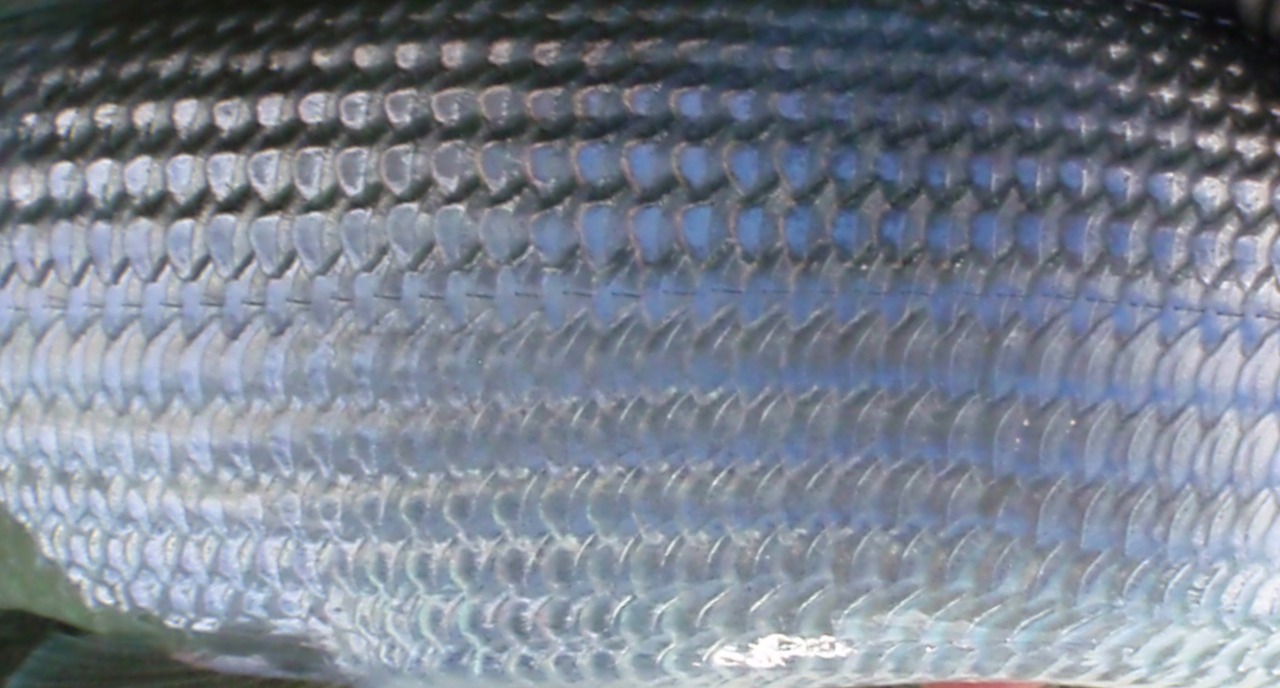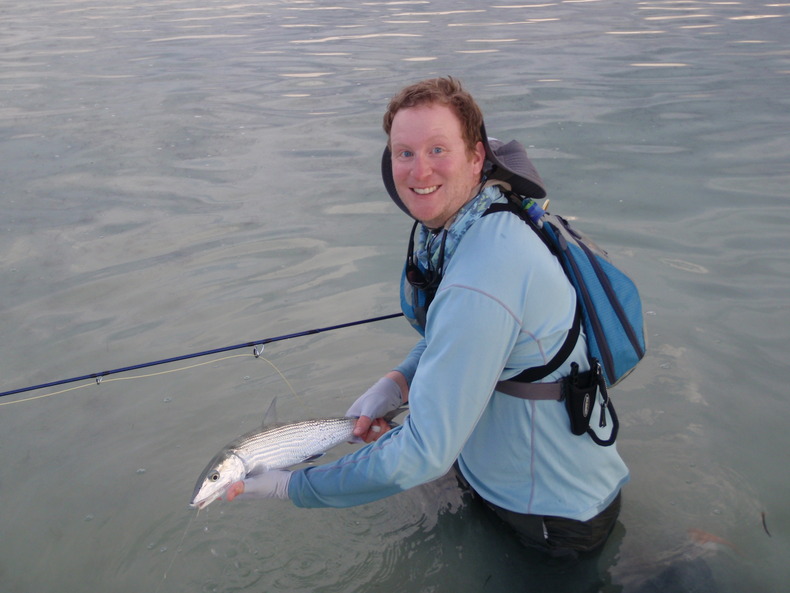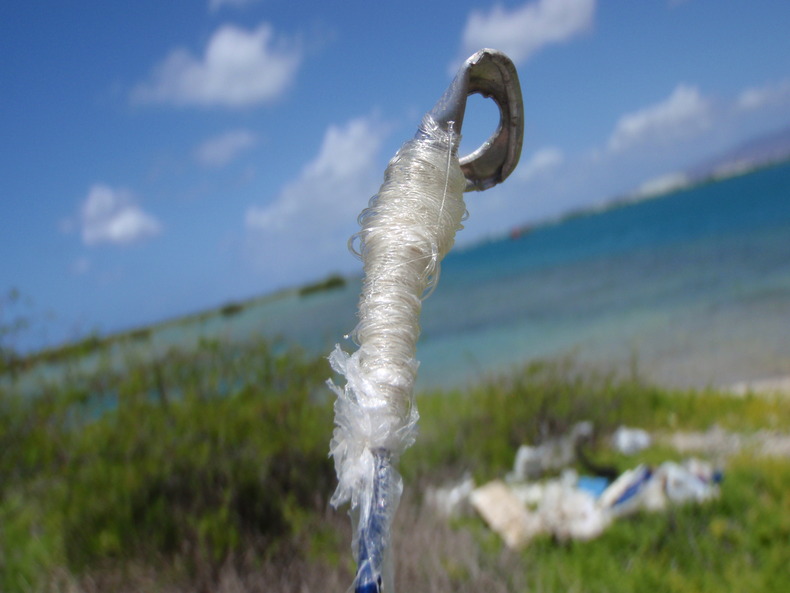Tanks with Tails
Trade Winds and Steady Hands
The idea of hooking into a Pacific bonefish has allure. Compared to the more popular destination waters, Hawai'i is close, and it is an American state (however, it is inexcusable to visit and not understand how this paradise came into the US and the price paid for your visit). If you've made the trek from the Pacific Northwest to an Atlantic fishery like the Bahamas in search of bonefish, you know it can be a long time before you finally step onto your first flat. A direct flight from Seattle is much nicer. What you find when you get off the plane is an enchanting fishery with huge rewards. Oversize, tough to hook, tougher to land rewards that get under your skin.
Oahu seems to be getting ever more popular as a bonefishing destination, with increasingly frequent mentions in fly fishing media. You've seen the stuff. Grip-and-grins with bones surely tipping the scales at 10+ lbs. and Jurassic Park scenery in the background. Sunshine, surf, palm trees, mai tais and huge bonefish? Cool, sign me up! After all, bonefishing isn't really that hard. You just have to be able to cast in the wind and be marginally accurate, right? Well I work in a fly shop so I should be good there. And I've caught fish in the Bahamas and Mexico, so no problem there. Should be fun.
A Bahamian bone and a happy angler
After wrapping up my time chasing steelhead, I had a whole summer ahead of me of double-digit fish and blistering runs. In fact, after conducting extensive research on Google Earth on my phone while on the plane to Honolulu, I identified key bonefish flats within an easy drive! And then my first day I immediately spotted a fish my first time out on my first flat. What incredible luck! It had taken me hours to find my first Bahamian bone, and they were super hard to see. Oh man, these Oahu fish are really screwed.
Excitable by nature, I spent that first outing throwing my fly at every single fish the very instant that I identified it as a monster Oahu bonefish.
25 ft. and closing fast. Double-haul and drop it on his nose! Yeah, great cast! Uh ... where did that fish go? Not sure. Well there's another one, 40 ft. away and in ankle-deep water! Get it out there, you might miss him. And there he goes. Weird. What about over there? Wait, maybe? 60 ft. by the mangrove, but I'm not even sure that's a fish! Side arming it should do the trick in this wind ... huh. That was definitely a fish, but why did he spook when I missed him by 15 ft.?
I recall this very strong confidence that if they saw my fly, they would simply swim over and eat it. After all, that's what pretty much every other bonefish in the world does. Why should these fish be any different?
Unfortunately for an angler who has only set foot on the beginner-level flats of the Bahamas and Mexico, Oahu bonefish are different indeed.

Before the Table Is Set for Feeding Time
It turns out that they are easy to spot. After all, they're huge. Oahu bones look like little greenish-turquoise torpedoes as soon as you start to look for them. Truthfully, unless the light is bad, it's pretty hard to miss them. When they tail it's like a freaking billboard, with huge scythelike forks waving as they sift. That really gets your blood pumping. But unless you've got the skills to close on the deal, spotting them means pretty much zilch.
Oahu bonefishing has a reputation for difficulty, and after a summer of getting to know the flats around Honolulu, I can wholeheartedly confirm that reputation.
Oahu bones are bastards!
They shun your presentations with extreme prejudice. Even if your fly does generate interest, sometimes characterized as an aggressive move where they rush your fly and suddenly stop short, they inspect it with care, inviting you to make a mistake. Do you think he ate it? If you strip set and you're wrong, you lose. Errant cast? You lose. Move the fly too little or too much? Might as well pack it up and go home.
Here's a couple entries based on the painful and humbling process I went through as I slowly learned the flats fishing around Oahu. I'm the first to admit that I've made just about every mistake in the HI bonefishing book. And just because I make the mistake once doesn't mean I'll never repeat it. Sure, sometimes the fish spooks, and you honestly wonder why. But most of the time you know exactly what you did wrong because you've made that mistake before, albeit in a slightly different way. That's the game. There are no shortcuts. It's about not missing opportunities, and in this fishery, it's about dealing with the all-too-frequent gut punch of a trophy bonefish streaming off the flat because you did something stupid.
Ways to F up Your HI Bonefish Shot #1
Cast too close, depending on the fish and conditions. In certain light, depth and clarity, that's within 15 ft. Make sure and admire the huge push of water an 8+ lb. bone displaces when he heads for deeper water.
Ways to F up Your HI Bonefish Shot #2
Strip too fast. Mantis Shrimp hop and bury themselves in the sand when threatened. They do not sprint mid-level in the water column, you idiot.
Ways to F up Your HI Bonefish Shot #3
Cast to an incoming fish, only to find that your incoming fish is one of a pair and you somehow missed the larger fish that's now directly under your cast. If lining trophy bonefish were the goal you'd be a legend by now.
Ways to F up Your HI Bonefish Shot #4
Got a follow! He's tracking! I'm stripping, stripping, stripppiiinnnggg—there it is! Strip set! And ... what? There goes the fish. Oh great, I hooked coral. The fly is lodged on the bottom because I didn't tie in a weed guard.
Necessity Breeds Innovation - New Tip Top In A Pinch
Ways to F up Your HI Bonefish Shot #5
Spot a fish and plot a course to intercept. Carefully walk over uneven coral. Realize it's a pod of a couple fish. Just as you are getting within casting range to still unsuspecting bones, you spook a small group of baitfish that freak out and stream right into the oncoming fish. Game over.
Ways to F up Your HI Bonefish Shot #6
You change to a heavier fly because the incoming tide is now causing sets of waves to slowly wash over the flat. That fly should simply stay put. Unfortunately, you don't adjust your leader to account for the weight, and the perfect shot you've been waiting for swims towards you. Too bad your cast crumples 15 ft. short and 30 degrees to the right of the fish's path.
... week elapse, during which time I graduate from ways to mess up your shot, hook a few screamers, and start a new list ...
Ways to F Up Landing Your HI Bonefish #1
Don't, under any circumstances, use 8 lb. test. Just don't do it. It doesn't matter, you're not gaining an advantage by reducing the size of your tippet. These fish are not trout. If you do, for some reason, drop to 8 lb., you will surely get a savage grab from the biggest fish on the flat. If the incredible acceleration of the initial run doesn't snap off the fly, any slight abrasion from the entire coral flat will ensure you will not land that bonefish. And there is a lot of that coral flat to encounter when your jumbo fish heads for deeper water. Need I remind you, you are not in the Bahamas!
Ways to F Up Landing Your HI Bonefish #2
In fact, while you're at it, don't use 12 lb. test. Not really worth it.
Ways to F Up Landing Your HI Bonefish #3
If you really don't like landing fish, make sure and pick a fly designed for weak, girly little bonefish. I made this mistake with a little spun-hair crustacean that was a leftover from my Bahamas box. Tasty vittles. I'm not sure what the hook on that one is, but it was definitely not Oahu strength. It lasted about half of the initial run before the hook bent out 90 degrees. Would have like to have landed that one. Later that month, the same thing happened to a fly tied on an Tiemco 811s: a heavy wire, high-quality forged hook. I probably didn't get a nice set on a long distance cast, but the pressure an accelerating bonefish puts on your gear out here is astounding.
Ways to F UP Landing Your HI Bonefish #4
Sometimes, it's not even your fault. Juvenile jacks eat the fly at the worst possible moment. Shadows from passing birds or airplanes cause Oahu bones to poo in their shiny pants and accelerate away from you. Sometimes a hooked fish will flee to deep water and leave your fly line and backing tangled in multiple points along the reef. Maybe you'll be able to get to the tangles, or maybe you'll lose your whole rigging. I never lost a fly line, but I came close.
And I am definitely finding new and creative ways to add to this list.
Still, despite the challenges, sometimes things do come together and you land a fish or two. Things happen so fast on the flats, you gotta be good and you have to be lucky. Wait for the shot, even if it seems like it's against the odds. I am a slow learner, and having lots of trips in good conditions really helped me. If you are reading this blog just to see what I've been up to this year, skip this next part and scroll down to the videos. But if you are looking for info on this fishery from an admitted flats noob, scouring the web and every possible web page, Instagram account, Facebook post, and amateur's blog on these ridiculously amazing Hawaiian bonefish, read on.
First, a disclaimer. If you really want to get the most out of this fishery, hire a local guide. You will exponentially increase your number of shots, and you'll have someone looking over your shoulder telling you where to cast, how to strip and when to set. There are a number of good guides on Oahu. How do I know they are good guides? Because you have to be good to get anyone into fish here. It's low numbers, high persistence fly fishing in constant wind and tough conditions. There aren't that many flats around here, so you run into, and sometimes fish right next to, the local guides. They know what's up. Hooking a HI bone is probably easier than getting into a fish winter steelheading on the swing, but until you know the ropes it really pays to have someone helping you out. And even if you don't get a guide, go to Nervous Waters Fly Fishers on Waialae. They helped me out a ton, freely sharing tips and techniques when I was doing it all wrong. Their fly selection is simply awesome, and they are the only place I found for tying materials in Hawai'i.
I enjoy learning a new fishery from the ground up even if it is difficult at first. What follows is a little of what I learned from my time on the flats around Oahu.
I spent pretty much all my time sight fishing, which is one of two methods for sticking bonefish around here. The second method is blind casting, and it consists of methodically covering water that bonefish are likely to use as they enter and exit a flat. One of the plusses of this method is that light spey rods are perfect tools, but I only had single handers with me. However, compared to stalking these fish with your eyes, blind casting is much less exciting. I have yet to land a fish here blind casting, but I'm willing to give it a go before I head back to Seattle.
The biggest key to success so far has been the time I've put in observing the fish. My thought process when I first arrived was pretty much: "throw the fly near the bonefish, strip it, and when you come tight don't trout set." After countless botched shots and a few victories here and there, the thinking has evolved quite a bit. It basically boils down to: "watch what the fish is doing and set a trap."
You have to see what the fish is doing. This can be hard in the dim light of dawn or if the fish is tailing. Noting the alignment of the dorsal fin and the tail helps, but even then they often change direction. You have to plot their course. Sometimes, this is easy and you land the fly right in line with the fish's destination. Other times you land a perfect cast and the fish changes direction. You win some, you lose some. Pretty standard bonefishing challenges.
Where Oahu is different is the distance that you must lead the fish. They are educated and super attuned to the disturbance of an indelicate cast. Leading by 10 ft. is probably about average for me, but sometimes that can be too close. How can you tell? It really goes back to observing the behavior of the fish. Are they being lethargic, slowly milling around from spot to spot and often turning and changing direction? Or are they streaming in from deeper water, moving with purpose and speed? Wary or aggressive? Two extremes, no doubt, but how the fish are moving really affects the distance you need to lead them.
It also helps to get to know the contours of a specific flat, fish it on different tides, and get a sense of when fish are there, where they are coming from and how they move across a flat. On more than one occasion I hooked a fish by taking advantage of the depressions in the coral, waiting in a specific spot for the next oncoming fish to slip into the more comfortable depth of the depression where my fly was waiting.
Once you land that cast and the fish hasn't spooked, you're ready for the toughest part of HI bonefishing: detecting an eat. Only a handful of times has a fish rushed over to the fly, gobbled it up, pulled line, hooked itself and blasted off on a run. It happens, and when it does it's awesome! But you can't rely on the suicide fish.
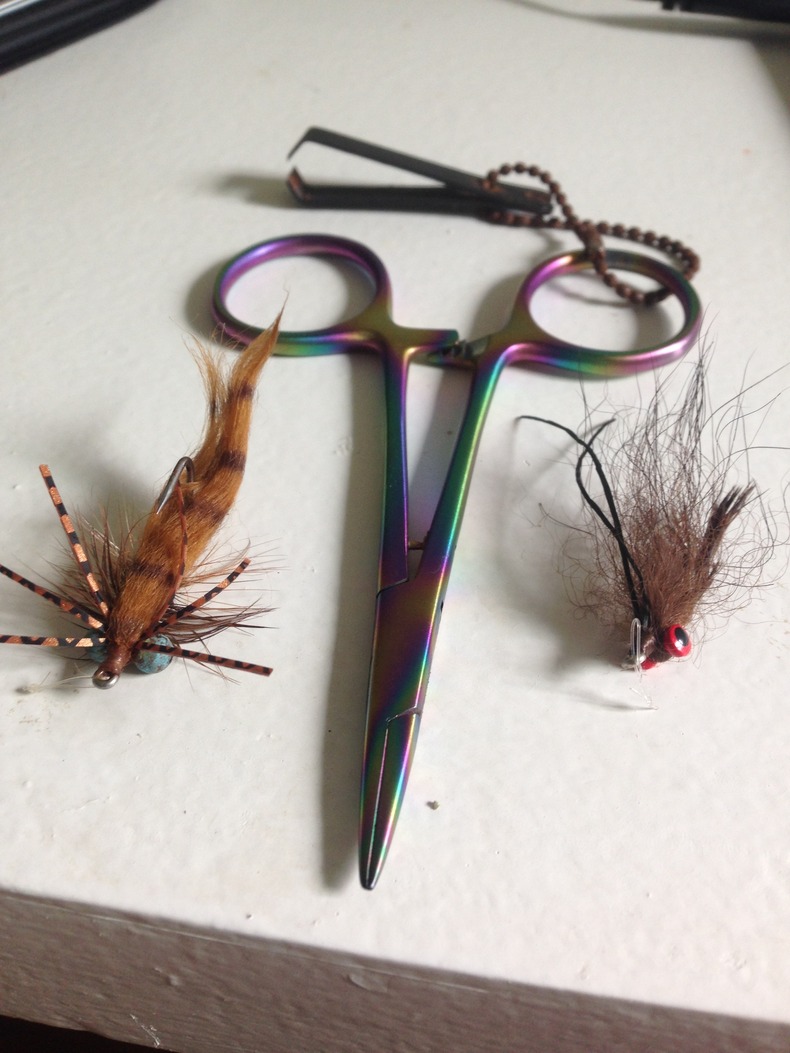
Tools of the Skinny Water Angler
If the fish are being responsive to your fly (sometimes they don't care), they'll make their way over to it. Sometimes it's a direct charge, other times it's a meandering, lazy swim. Once they get to your fly, it's important to leave it be. Keep your line under tension and get ready, but don't flinch. It's really hard to tell when they eat. Especially when you're on foot. Maybe you'll see them tip towards it, or tail, or do a little shimmy, or maybe they just slow down and pause. When you think you've got an eat, smoothly strip set your fly. I'll tell you it's a difficult feat, but once you trick a nice HI bone into eating a fly that you've laid in front if it, it's a great feeling! The fish is in plain sight, you watch the whole thing unfold as you simultaneously feel the connection to the fish. The reward is a long, powerful run that, at minimum, takes you into your backing.
Keeping the fish attached during these runs is a crap shoot in itself with so much coral around. There is apparently some mojo you can learn to prevent the fish from attaining top speed, but at this stage of the game for me, I have no idea why I'd want to do that. I love the run!
If everything goes right with that first crazy run, you're most of the way there. The big fish seem to run forever before you can turn them around, and getting them back is basically a lot of reeling. Sometimes you'll get a smaller, secondary run out of a spunky fish, which is also pretty fun. As you get them close, they come in pretty easily.
Second Run ... Is He Ready To Come In Yet?
A couple fish where it's happened correctly.
I'm writing this post at the end of my time in Honolulu, and with tropical depression Kilo throwing huge amounts of moisture our way, the week of sight fishing I had planned is kaput. I may, at best, get a couple days right before I head out, weather gods willing. Pretty tough break, as I felt like I was just getting the hang of the tides, locations, flies and presentations. And, although I came tight to some nice fish, there was one in particular that will stick out in memory when I think back to my time on the flats of Oahu.
One of the best days was during a big, incoming tide. I had gotten an eat and missed the set, landed the next fish, and hooked and lost the one after that. This all happened in the span of about an hour. It was a good tide and I was riding pretty high. It seemed like there were fish streaming in, actively moving and aggressively feeding. The fish that I had landed was in relatively deep water, and he was one of a pod of five or six. To be fair, I was sitting in the first likely spot they'd come across to feed after they come out of deep water onto the flat, but all the same, this is a shocking number of bonefish! In theory they come in from the ocean in big pods and then spread out, but all the same it's nice to see more than a single or a double. Straight up, there were fish around.
As I was making my way to my favorite part of the flat, I was wading in shin deep water in order to cover more ground. I was moving fast enough to feel like I was getting somewhere, but not so fast that I would automatically spook any fish I might encounter. While thinking how I was excited to get into deeper water where I could surely hook another fish, I either heard a splash or saw some movement or something over my left shoulder, and I turned to look.
About 15 ft. away, I saw a pod of three bonefish: two little guys and one big guy. They were in skinny water, and the big fish was tailing to eat something, making a ruckus. I think his splash is what attracted my attention. The difference in size between the wee ones and the jumbo was laughable. The smaller fish were right at home in that water, cruising confidently and hardly disturbing the surface. The jumbo looked like an elephant in a hot tub. Or a fat guy in a little coat. He was absurd compared to his little brothers. I was sure my clumsy walking would have given me up, but they were temporarily unaware I was watching. The pod was headed towards me, and my window would not be long.
It's funny how quickly you can process things in a situation like that. It went from me noticing something, to spotting the fish, being afraid I was going to spook them, realizing I hadn't, resolving to act quickly, tracking their movement, gauging where and when to cast, to firing my mantis about 6 ft. ahead of the pod. I was pretty sure the whole group would spook, but I gave it a go anyway. As soon as the fly hit the water, the jumbo bolted over and hammered the fly. I didn't need to set, I just tightened up and watched the run of the biggest fish I've hooked on Oahu.
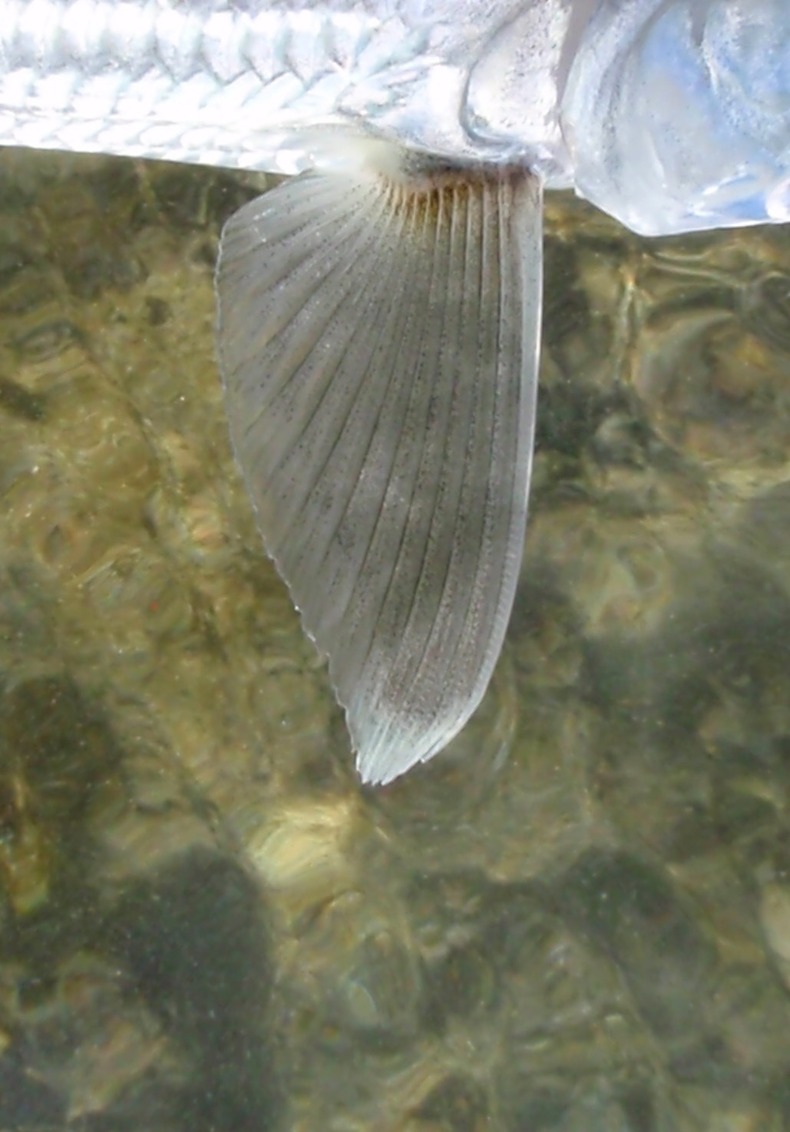
Fins Built For Speed
He flipped out. I let out a holler as he charged one direction, then the next, trying to get this crazy crustacean thing out of his mouth. Maybe he shouldn't have been such a pig and let the little guys have a turn at that trough, yah? He swam directly towards me and I had to lift my rod, strip, and walk backwards to try to keep him tight. He veered to the right in front of me, picking up speed as he turned, and then was headed away from me. I let line slip until I was tight to the reel, and man alive did that Tibor make a sweet sound. He was hauling toward the horizon at top speed. I wasn't sure how big he was but I would get a measurement next to the rod! And that's when the line went suddenly slack.
Still amped from the eat, I reeled in my line. The leader was abraded and cut in the 20 lb. section, about 3 ft. from the fly. Damn. Coral. I retraced the path the fish took as he ran, and realized that it was right along a section of the flat where there was a distinct change in depth. A ridge where there was about a foot to a foot and a half of distance between the sandy bottom and the coral flat. He had used the depth provided by that ridge to get up to ludicrous speed, and any little snag he hit would snap the leader no problem. Well played, jumbo o'io. Of course he took the fast lane.
In retrospect, he ate because there was a competitive element to the situation. He saw a mantis, he was bigger then his wingmen, and therefore, to him went the spoils. I hope that will happen to me at some point again, but realistically I know it probably won't.
Just like any other fishery, the fish have moods. Sometimes they are aggressive to the point of stupidity, but just like in any other place, this is rare. More often then not they are wary to the point of neurosis. After all, when there are jacks, sharks, and a sea filled with bigger, toothier fish that want to eat you, you gotta be twitchy to survive.
The biggest thing I took away from my time in Honolulu was the peace of fishing the flat. Even though you are in a dense metropolitan area, there is a knee-deep wilderness about 20 min. away. Rays, mini blacktips, bluefin jacks, eels, sea turtles and dolphins are part of the scenery. The critters that crawl with the outgoing tide are fascinating, and the endless variety of little reef fish make that aquarium in your dentist's office look like a cruel joke. Just like our local trout streams, steelhead runs, or Puget Sound beaches, you can put in your time in the skinny waters and unlock the puzzle. There are tiny little access points hidden in plain sight as you drive around the city, and the fish sure don't know there are a bunch of hotels right by their favorite feeding grounds. I spent the entire summer sight fishing a handful of productive flats, but had I brought a spey rod a whole other realm of fishing would have been open to me with its own nuance and potential. And, should I ever reach the point where I don't get a thrill from stalking these saltwater carp of Hawai'i, there are innumerable other species that respond to the fly, including the elusive ulua.
Good fishing is where you find it. It often doesn't conform to your preconceived notions. You gotta adapt. And once you do, it's easy to feel at home even in the middle of the Pacific.
A Season For Steelhead, Powder, Waves and Bonefish
